As you step into the cockpit of a private jet, the hum of the engines and the soft glow of the instrument panels envelop you, making you feel like you're at the helm of a high-tech machine. But what makes these aircraft so safe? It's not just the sleek design or the advanced avionics – it's the rigorous maintenance schedules, meticulous inspections, and strict adherence to regulations that make private jets incredibly safe. With skilled technicians scrutinizing every component and pilots undergoing rigorous training, you can trust that your safety is in good hands. But what else contributes to this impressive safety record?
Rigorous Maintenance Schedules
Reliability is the backbone of private jet safety, and it's achieved through rigorous maintenance schedules. As a traveler, you can take comfort in knowing that these aircraft are subject to a rigorous upkeep regimen. Think of it like a regular check-up with your doctor – a series of meticulous inspections, repairs, and replacements designed to identify potential issues before they become major problems.
Airplane mechanics scrutinize every component, from propellers and engines to fuel systems and electronics. Even minor flaws or anomalies trigger corrective actions.
Turbulent conditions like turbulence or icing also dictate regular inspection of exterior and interior structures, avionics systems and environmental controls.
Given their extreme climate, planes fly mostly along lower skies hence limiting downtime related consequences flying turbulent parts outside restricted climb segments using heavy scheduled spare unit upgrades replacements.
Extensive manufacturers compliant or full checks combined further less-such condition data get sourced scheduling guidelines assist over one fleet company works seamlessly standard of real inspections running plane readiness soaring times change hands here the task won't land hours within operation pre-passport high winds grounds long one such not making other lost night repairs – Not sparetaboola time isn
Advanced Safety Features

With rigorous maintenance schedules in place, private jets are well-equipped to handle the demands of flight. But that's not all – they're also packed with advanced safety features that give you an extra layer of protection.
You'll find state-of-the-art avionics systems, like GPS and autopilot, which enable pilots to navigate with precision and accuracy. These systems are designed to reduce pilot workload, minimizing the risk of human error.
You'll also find advanced weather radar systems, which provide real-time data on weather conditions, allowing pilots to make informed decisions about flight routes and altitudes.
And, with advanced collision avoidance systems, you'll be alerted to potential hazards, giving you plenty of time to react. Furthermore, many private jets are equipped with advanced life support systems, including oxygen generators and emergency medical equipment, as a supplement to their safety arsenal.
These features work together to create a safe and secure flying environment, giving you peace of mind as you soar through the skies. With these advanced safety features on board, you can focus on enjoying your flight, knowing you're in good hands.
Regular Inspection Protocols
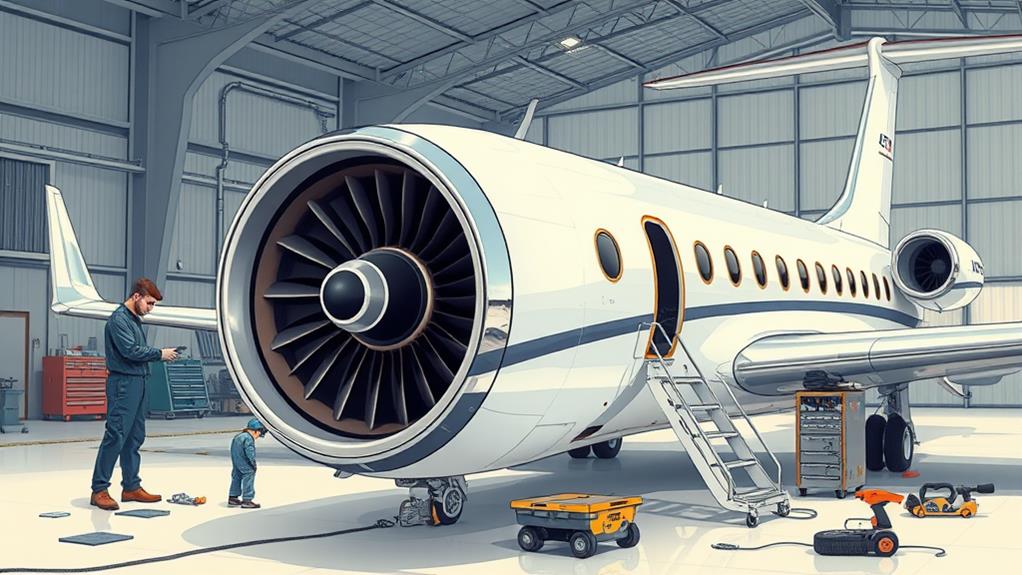
Maintained to the highest standards, your private jet undergoes rigorous inspections to guarantee every system, component, and appliance is functioning correctly.
These inspections are a pivotal part of verifying your safety and the total performance of the aircraft. You can expect a thorough examination of the airframe, engines, avionics, and other essential systems to detect any potential issues before they become major problems.
The inspection process involves a series of checks, including visual inspections, functional tests, and analysis of maintenance records.
Skilled technicians scrutinize every aspect of the aircraft, from the control yoke to the landing gear, to certify compliance with stringent regulations.
Your private jet will undergo multiple types of inspections, such as routine checks every 25-50 flight hours, in addition to more in-depth maintenance procedures like "C" and "D" checks, which can occur every 1,500 to 6,000 hours, depending on the type of aircraft and usage.
With these protocols in place, you can rest assured that your private jet is always airworthy and ready for your next flight.
Regular inspections provide peace of mind and certify a safe flying experience.
Highly Trained Pilots
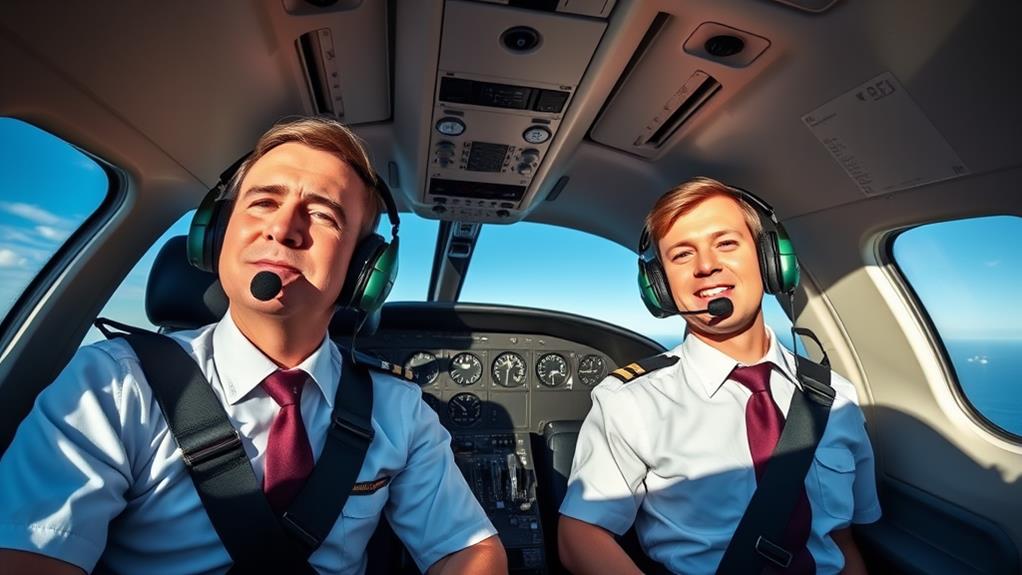
Your safety in the air also depends on the expertise of the pilots flying your private jet.
These highly trained professionals undergo rigorous training and adhere to strict standards to guarantee your safety.
They're not just skilled at flying the plane, but also at handling emergency situations and making quick decisions under pressure.
Pilots undergo an intensive training program that covers everything from aircraft systems to weather patterns and emergency procedures.
They're required to complete regular training sessions to stay up-to-date with the latest techniques and technologies.
They practice flying in realistic simulator environments, honing their skills in a safe and controlled setting.
They're regularly evaluated by certified check airmen to guarantee they're meeting the highest standards of safety and proficiency.
With highly trained pilots at the controls, you can feel confident that your private jet is in good hands.
Their expertise and experience are vital to guaranteeing a safe and enjoyable flight.
Proven Aircraft Designs
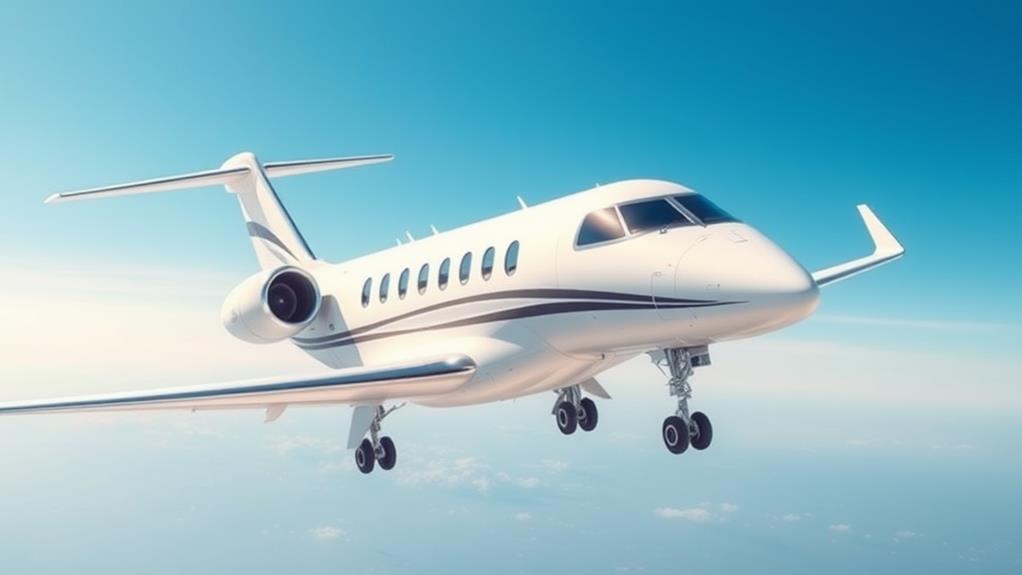
Proven aircraft designs are the backbone of private jet safety. When you step aboard a private jet, you're placing your trust in the hands of expert engineers who've spent years perfecting their craft.
The most reputable manufacturers, like Gulfstream and Bombardier, have spent decades honing their designs through rigorous testing and iteration. You can feel confident knowing that the aircraft has undergone extensive flight testing, stress testing, and analysis to guarantee it meets the highest standards.
From the sturdy airframe to the reliable engines, every component has been carefully considered to minimize risk.
Modern materials, like lightweight composites and advanced alloys, are used to optimize performance and reduce the risk of failure. Advanced avionics systems provide pilots with critical data in real-time, allowing them to make informed decisions.
Proven designs have stood the test of time, and many have undergone significant upgrades and refinements to stay ahead of the curve. This focus on reliability and durability translates into an exceptional level of safety, giving you peace of mind as you soar through the skies.
Strict Safety Regulations

As you trust your safety to the expertly designed aircraft, you also rely on the strict safety regulations that govern the private jet industry.
These regulations are in place to guarantee that every flight is a safe one.
- Regular Maintenance: Private jets must undergo regular maintenance checks to certify that all systems are functioning properly.
- Pilot Training: Pilots must undergo rigorous training to guarantee they can handle any situation that may arise during flight.
- Airworthiness Directives: Private jets must comply with strict airworthiness directives to guarantee they're airworthy and safe to fly.
- Safety Inspections: Regular safety inspections are conducted to identify and address any potential safety concerns.
These regulations are in place to guarantee that private jets are safe to fly, and that passengers can trust their safety to the expertly designed aircraft.
Enhanced Weather Radar
When flying on a private jet, you'll often find yourself traversing through unpredictable weather conditions.
That's why advanced weather radar is a vital component of private jet safety. This sophisticated technology allows pilots to detect and track weather patterns in real-time, giving them the ability to steer through even the most turbulent skies.
With advanced weather radar, pilots can identify potential hazards such as thunderstorms, turbulence, and icing conditions, and make informed decisions to guarantee a safe and smooth flight.
This sophisticated system provides detailed, high-resolution images of weather patterns, allowing pilots to anticipate and respond to changing weather conditions. By detecting weather patterns early, pilots can adjust flight paths, altitudes, and speeds to minimize risks and guarantee a safe passage.
Whether flying through dense fog or steering through a severe thunderstorm, advanced weather radar provides pilots with the critical information they need to make split-second decisions that can mean the difference between a safe landing and a potentially disastrous outcome.
With this technology, private jets can operate safely and efficiently, even in the most challenging weather conditions.
Advanced Avionics Systems

Private jets have become synonymous with luxury, sophistication, and above all, safety.
As you step aboard, you'll notice the advanced avionics systems that play a critical role in guaranteeing your passage is smooth and secure.
These systems are the brain of the aircraft, providing pilots with real-time data to make informed decisions.
- High-resolution displays: Advanced avionics systems feature high-resolution displays that provide pilots with crystal-clear information, from navigation charts to engine performance data.
- Automated systems: Automated systems, such as autopilot and autothrottle, reduce pilot workload and minimize the risk of human error.
- Real-time weather updates: Advanced avionics systems receive real-time weather updates, enabling pilots to make informed decisions about flight routing and altitude.
- Heightened situational awareness: Advanced avionics systems provide pilots with heightened situational awareness, including traffic alerts and terrain warnings, to guarantee safe separation from other aircraft and obstacles.
These advanced avionics systems work together to create a safe and efficient flying experience.
With the ability to process vast amounts of data in real-time, pilots can focus on what matters most – getting you to your destination safely and comfortably.
Robust Emergency Procedures
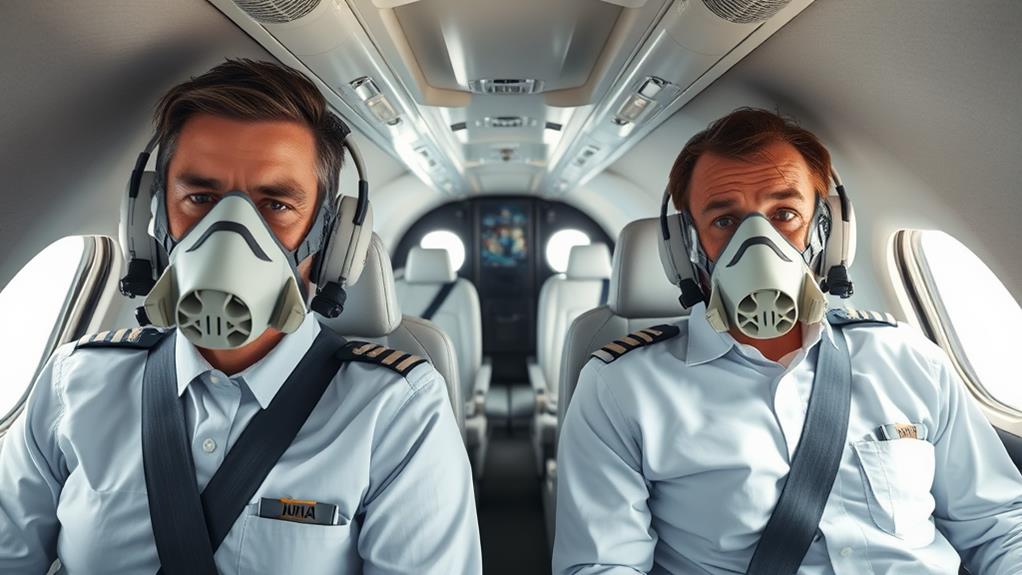
Robust emergency procedures are a cornerstone of private jet safety, providing an added layer of security in the unlikely event of an unexpected situation.
As you board a private jet, you can take comfort in knowing that emergency protocols are in place to address any unexpected situation.
Emergency oxygen systems, for instance, provide a steady supply of breathable air in case of loss of cabin pressure.
You'll also be reassured by the presence of fire-resistant materials, carefully selected to minimize the risk of fire in the event of an engine failure.
Furthermore, regular training certifies that flight attendants and crew are equipped to handle any situation, from medical emergencies to unexpected turbulence.
And in case of a full-blown crisis, well-defined emergency procedures swing into action, with precision-designed evacuation slides guaranteeing a safe exit from the aircraft.
In the same vein, portable defibrillators on board enable quick response to medical emergencies, further enhancing your safety on board.
You're safe in the hands of highly trained crew who'll do everything possible to minimize risk.
Stringent Security Measures
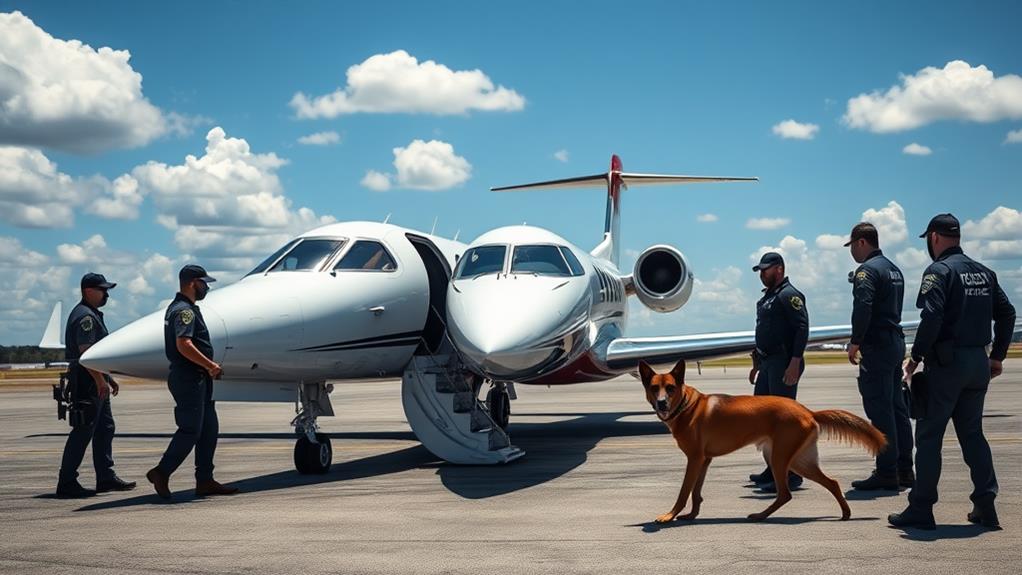
As you step aboard a private jet, stringent security measures kick in, designed to safeguard you from potential threats.
You'll notice a heightened sense of security, with measures in place to protect you from the moment you arrive at the airport.
- Background checks are conducted on all passengers, crew members, and ground staff to guarantee everyone on board is trustworthy.
- Private jets often have their own security personnel, who are trained to handle emergency situations and provide an added layer of protection.
- Airports with private jet terminals typically have more stringent security protocols, including biometric scanning and advanced surveillance systems.
- Private jets are also equipped with state-of-the-art security features, such as secure communication systems and GPS tracking devices.
These measures work together to create a secure environment, giving you peace of mind as you travel.
You can relax, knowing that your safety is the top priority.
With private jets, security isn't just a concern, it's a guarantee.
Frequently Asked Questions
Can Private Jets Fly in Extreme Weather Conditions?
You're wondering if private jets can handle extreme weather. Generally, they can fly in diverse conditions, but pilots exercise caution in severe weather. You'll likely be rerouted or delayed if conditions are too hazardous.
How Do Private Jets Handle Medical Emergencies on Board?
You're cruising at 30,000 feet, and suddenly a medical emergency unfolds – it's like a storm brewing in a teacup. Private jets are equipped with emergency medical kits, and crew members are trained to respond swiftly.
Are Private Jets More Susceptible to Cyber Attacks?
You're probably wondering if private jets are more vulnerable to cyber attacks. Honestly, yes, they are. With increasing reliance on digital systems, private jets' connectivity makes them more susceptible to hacking and cyber threats.
Can Private Jets Be Equipped With Defense Systems?
Imagine flying on a private jet with a built-in missile defense system like the one Northrop Grumman installed on a Gulfstream III. You can equip private jets with defense systems, like flares and electronic countermeasures, for added security.
Are Private Jet Passengers Screened for Security Threats?
You're wondering if private jet passengers are screened for security threats. Yes, they are! You'll undergo similar security checks as commercial airlines, including ID verification, luggage screening, and sometimes, supplementary measures like background checks and pat-downs.
Conclusion
As you step aboard a private jet, you're basically getting into a finely tuned machine that's been meticulously maintained and inspected. Think of it like a Swiss watch – every component is precision-crafted and rigorously tested to guarantee flawless operation. With advanced safety features, highly trained pilots, and robust emergency procedures in place, you can trust that your travel will be smooth and secure. In fact, private jets have an impressive safety record, with a 0.01% accident rate per 100,000 flight hours.